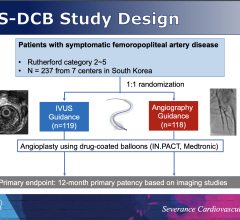
John P. Boehmer, MD, professor of medicine and surgery at The Pennsylvania State University in State College, Pennsylvania
March 7, 2023 — People with heart failure were 38% less likely to be readmitted to the hospital for heart failure complications within 90 days if they wore a stick-on sensor that alerted their clinician about fluid buildup in the lungs, according to a study presented at the American College of Cardiology’s Annual Scientific Session Together With the World Congress of Cardiology.
By providing clinicians with actionable information about a patient’s condition remotely, the device encourages clinicians to adjust medications earlier and prevent complications from escalating. Since it can be easily applied and removed, the experimental device could offer a less invasive and more cost-effective alternative to implantable sensors.
“It’s very exciting to have a positive result within the remote monitoring field,” said John P. Boehmer, MD, professor of medicine and surgery at The Pennsylvania State University in State College, Pennsylvania, and the study’s lead author. “Having a wearable technology is particularly encouraging because it gives you the opportunity to monitor a patient during a high-risk interval and then stop monitoring when they exit that high-risk interval.”
Heart failure is when the heart becomes too weak or too stiff to pump blood effectively throughout the body. It affects over six million adults in the U.S. and is associated with high health care and economic costs due to frequent hospitalizations and premature deaths.
Patients with heart failure are typically advised to weigh themselves daily and closely monitor signs of swelling and other symptoms like fatigue, shortness of breath and chest pain. Despite these measures many patients wind up back in the hospital within months after a heart failure hospitalization, often due to fluid buildup in the lungs. The study sought to reduce hospital readmissions by helping patients and clinicians monitor for early signs of fluid buildup and intervene before hospitalization is needed.
The µCor (“microcor”) system uses radiofrequency signals to assess the wearer’s thoracic fluid index, a measure of fluid in the lungs. It is attached to the left side of the chest with an adhesive patch and sends data to the patient’s clinician. For the study, the researchers enrolled 522 people within 10 days of hospitalization for heart failure. All patients were fitted with a µCor monitor, which they wore continuously for 90 days.
Half the patients were enrolled to a control group; these patients wore the µCor monitor, but information from the monitor was not sent to their clinician. This arm began first, and researchers used the data from this group to establish a threshold distinguishing between normal and elevated thoracic fluid levels. The patients enrolled in the intervention arm wore the monitor and the data was sent to their treating clinician along with action alerts if their thoracic fluid level crossed the established threshold.
Patients whose clinicians monitored thoracic fluid using the µCor system were 38% less likely to be hospitalized for heart failure within 90 days (the study’s primary endpoint) compared with patients whose clinicians did not receive this information. They were also 38% less likely to experience a combined endpoint that included heart failure-related emergency department visits, hospitalizations or deaths.
“The challenge in remote monitoring studies is to get clinicians to react to the data,” Boehmer said. “Our temptation is to look at the data, but then manage patients as we always have managed patients. There was a clear threshold set up in this trial, and the clinicians did react to it. As a result, we saw treatment interventions that seem to have been effective.”
Common interventions in response to evidence of fluid buildup include prescribing diuretics to reduce fluid retention, as well as increasing the dosage for a patient’s other heart failure medications. Since the µCor system provides information about changes in the lungs before symptoms such as swelling become apparent, researchers said the device can encourage clinicians to take such steps earlier and prevent complications from worsening
Several existing devices are available to monitor for signs of heart failure complications. These include implantable cardio-defibrillators (ICDs) and insertable loop recorders, which monitor for abnormal heart rhythms that often coexist with heart failure, as well as the shoulder-mounted ReDS system, which monitors for fluid in the lungs. Boehmer said µCor offers an alternative that is more convenient than the bulkier ReDS device while being less invasive than implantable devices. It can also be used intermittently to monitor patients only during high-risk periods, such as after a hospitalization, avoiding overburdening clinical staff with unnecessary data and focusing resources on the patients who can benefit most from close monitoring.
Boehmer said that the study was moderately sized and not randomized; a larger, randomized trial would help to confirm the findings. In addition to its measurements of thoracic fluid, researchers plan to study how additional data collected by the µCor device, such as heart rate and breathing rate, could be incorporated into the data provided to clinicians to offer a more comprehensive picture of a patient’s condition. It is also possible that the device could be useful for monitoring patients with lung diseases in addition to heart failure, researchers said.
The study was funded by Zoll Medical Corporation, developer of the µCor system.
For more information: www.acc.org


 July 31, 2024
July 31, 2024 








